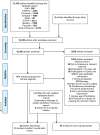Peer-facilitated community-based interventions for adolescent health in low- and middle-income countries: A systematic review
- PMID: 30673732
- PMCID: PMC6343892
- DOI: 10.1371/journal.pone.0210468
Peer-facilitated community-based interventions for adolescent health in low- and middle-income countries: A systematic review
Abstract
Background: Adolescents aged 10-19 represent one sixth of the world's population and have a high burden of morbidity, particularly in low-resource settings. We know little about the potential of community-based peer facilitators to improve adolescent health in such contexts.
Methods: We did a systematic review of peer-facilitated community-based interventions for adolescent health in low- and middle-income countries (LMICs). We searched databases for randomised controlled trials of interventions featuring peer education, counselling, activism, and/or outreach facilitated by young people aged 10-24. We included trials with outcomes across key areas of adolescent health: infectious and vaccine preventable diseases, undernutrition, HIV/AIDS, sexual and reproductive health, unintentional injuries, violence, physical disorders, mental disorders and substance use. We summarised evidence from these trials narratively. PROSPERO registration: CRD42016039190.
Results: We found 20 studies (61,014 adolescents). Fourteen studies tested interventions linked to schools or colleges, and 12 had non-peer-facilitated components, e.g. health worker training. Four studies had HIV-related outcomes, but none reported reductions in HIV prevalence or incidence. Nine studies had clinical sexual and reproductive health outcomes, but only one reported a positive effect: a reduction in Herpes Simplex Virus-2 incidence. Three studies had violence-related outcomes, two of which reported reductions in physical violence by school staff and perpetration of physical violence by adolescents. Seven studies had mental health outcomes, four of which reported reductions in depressive symptoms. Finally, we found eight studies on substance use, four of which reported reductions in alcohol consumption and smoking or tobacco use. There were no studies on infectious and vaccine preventable diseases, undernutrition, or injuries.
Conclusions: There are few trials on the effects of peer-facilitated community-based interventions for adolescent health in LMICs. Existing trials have mixed results, with the most promising evidence supporting work with peer facilitators to improve adolescent mental health and reduce substance use and violence.
Conflict of interest statement
The authors have declared that no competing interests exist.
Figures

References
-
- UNICEF. Progress for children: a report card for adolescents. 2012 April 2012. Report No.: Contract No.: 10.
-
- World Health Organization. Global health estimates 2015: deaths by cause, age, sex, by country and by region, 2000–2015 Geneva2016. http://www.who.int/healthinfo/global_burden_disease/estimates/en/index1.....
-
- Mokdad AH, Forouzanfar MH, Daoud F, Mokdad AA, El Bcheraoui C, Moradi-Lakeh M, et al. Global burden of diseases, injuries, and risk factors for young people’s health during 1990–2013: a systematic analysis for the Global Burden of Disease Study 2013. Lancet. 2016;387(10036):2383–401. 10.1016/S0140-6736(16)00648-6 - DOI - PubMed
Publication types
MeSH terms
LinkOut - more resources
Full Text Sources
Medical
Molecular Biology Databases

